Autonomous Driving Simulation Industry Chain Report (Chinese Companies), 2022
Simulation Research (Part II): digital twin, cloud computing, and data closed-loop improve simulation test efficiency.
Simulation tests can not only be conducted in extreme working conditions and more complex scenarios and make ADAS/ADS verification more effective, but also reproduce and generalize the real vehicle test data, allow for deeper analysis of the problems in real vehicle tests and make corresponding optimizations, speeding up function development and shortening test cycle. The higher efficiency of autonomous driving simulation tests comes with the adoption of such technologies as digital twin, cloud computing, and data closed-loop.
1. Digital twin technology will help to build more extreme test scenario combinations.
Scenario libraries are the basis of simulation tests, and digital twin technology is a powerful tool for building virtual scene libraries. To ensure the safety and reliability of vehicles, OEMs need to test almost unlimited scenarios. By referring to the real world, digital twin technology can be used to model a 3D elements library quickly and automatically, and build different roads, marking lines, weathers, surroundings and other scenarios to achieve more possible test scene combinations, thus enabling high-precision simulation of sensors, environments, vehicle dynamic models, etc. Especially in the software OTA regression testing, digital twin can also greatly improve the efficiency of simulation testing and verification.
At present, Chinese comprehensive simulation platforms like Baidu, Huawei, Tencent and Alibaba, as well as specialist simulation testing service providers such as IAE, have all used digital twin technology for scene construction.
Huawei Octopus Platform can convert the collected typical road sections into simulation scenes, and combine them with HD maps to realize digital twin of real scenes. It can not only restore more than 95% scenes, but also give great assistance to developers to quickly simulate surrounding vehicles and realize minute-level scene construction. The platform with built-in 200,000 simulation scenes can provide application tools such as simulation, scene library management, scene fragment and evaluation system, as well as high-concurrency instance handling capabilities.
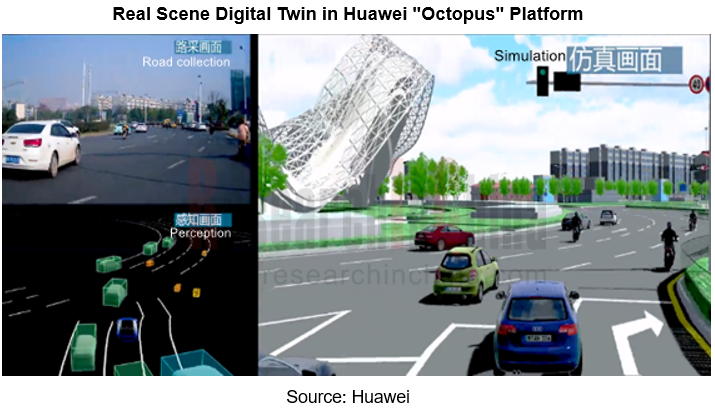
Tencent's autonomous driving digital twin simulation test platform TAD Sim (upgraded to 2.0) uses real data and gaming technology as dual-engine drive, covers simulation models such as road scene, traffic flow, vehicle sensing and vehicle dynamics, and supports OpenX and OSI international simulation standards. It offers more than 1,000 scene types, and can also generate larger-scale, rich scenes through generalization.
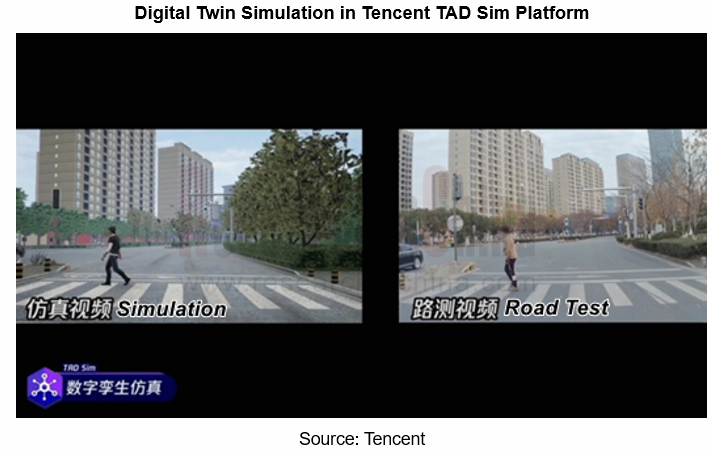
Founded in 2018, IAE is committed to building the world's largest simulation test scene workshop (massive scene libraries) with high precision, high confidence, high coverage and high freshness, and providing simulation scene data and SaaS (Scenario-as-a-Service). Its "Shuimu Lingjing" Scene Workshop is built according to the related Chinese and foreign intelligent connected vehicle industry standards, real roads and traffic behavior characteristics. With artificial intelligence and digital twin as underlying technologies, and the cross-platform and big data drive as the principle, the platform can be used to develop and build a whole-process and automated tool chain covering scene data collection, processing, analysis and mass production, realize large-scale, high-quality production of simulation scenes, and build a core support system required for large-scale algorithm training, simulation testing and evaluation. At present, IAE has built more than 8,000 groups of actually available simulation scene libraries, covering city-level digital twin, autonomous driving, Chinese and foreign regulations and standards, CIDAS traffic accident recurrence, safety of the intended functionality, and V2X.
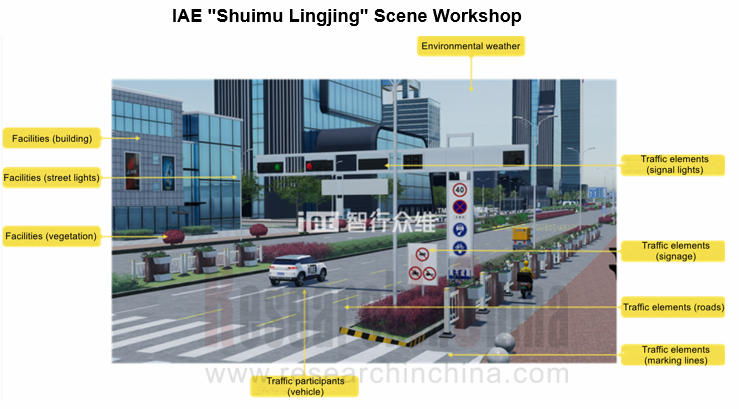
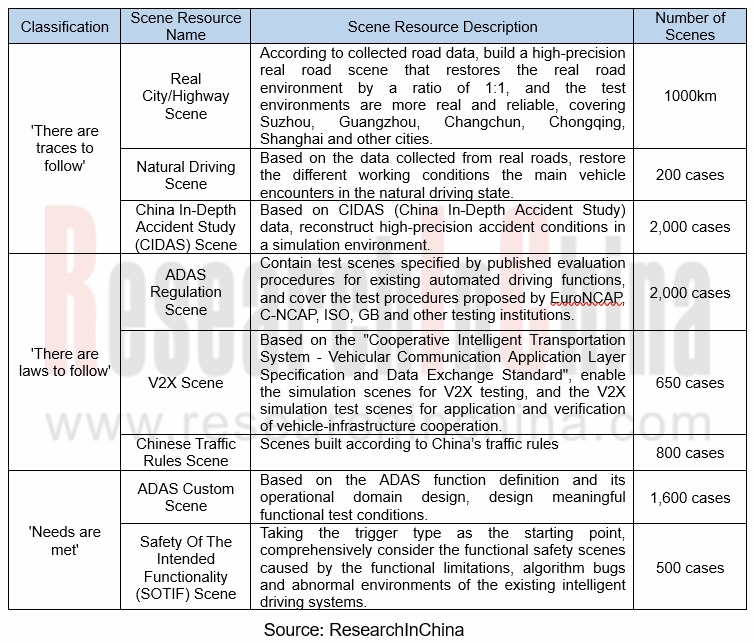
2. The simulation testing based on cloud high-concurrency operation will further improve iteration efficiency of ADAS/ADS functions.
For advanced function development and intended functionality development, the autonomous driving simulation test platform needs to offer real restoration test scenes, make good use of collected road data to produce simulation scenes, and be capable of large-scale parallel processing on the cloud, so as to answer the needs of autonomous driving for closed-loop testing of perception, decision and control full-stack algorithms. Currently, technology giants, automakers, solution providers, and simulation software companies are working to expedite the construction of virtual simulation cloud platforms.
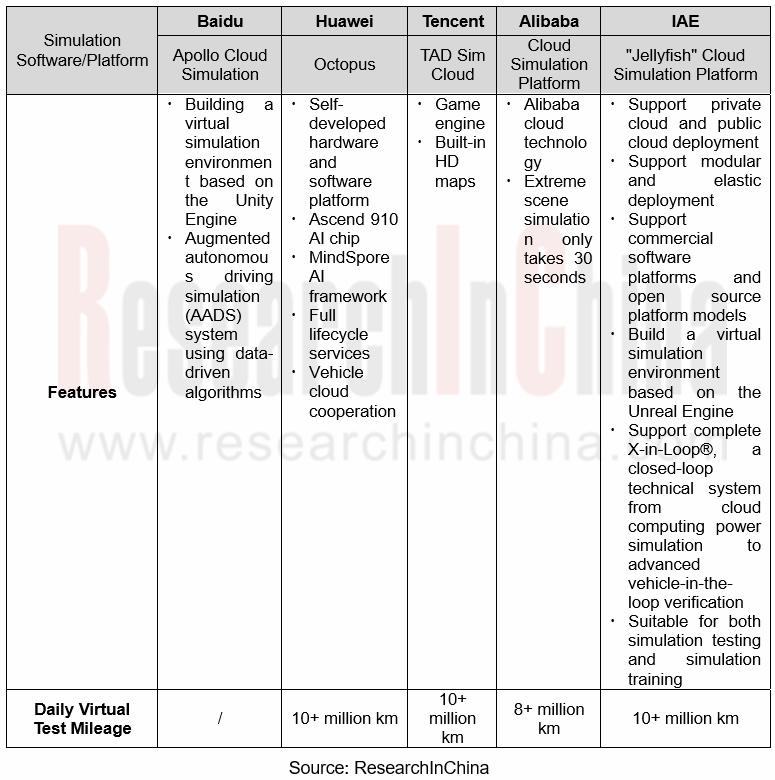
Baidu Apollo Simulation Platform is a cloud service built on Baidu Cloud and Azure. It improves the operating efficiency of simulation platforms through the large-scale distributed and dynamic variable speed simulation. Based on the large-scale cloud computing capacity, Apollo has created a virtual operating capability of millions of kilometers per day, and has built a fast iterative closed loop, making it easy for developers to achieve "millions of kilometers per day", greatly improving the development efficiency.
Alibaba Cloud Autonomous Driving Simulation Platform supports flexible, high-concurrency simulation and provides traffic flow simulation that can generate simulation traffic flows that conform to the element features and control methods of Chinese roads. Combined with autonomous driving simulation software, the platform enables game simulation, completing construction and testing of special scenes such as rainy/snowy weather and poor lighting conditions at night within 30 seconds. The Alibaba Cloud Platform favored 20 times faster autonomous driving simulation for Inceptio in 2022.
IAE "Jellyfish" Massive Simulation SaaS Platform can be deployed on private cloud and public cloud in a modular and elastic manner, and supports hypervisor, Docker and other modes. Besides designing and building cloud simulation platforms for customers, the company also builds a 400-node massive simulation SaaS platform based on proprietary cloud, with the virtual simulation test capability of daily effective mileage of more than one million kilometers, providing customers with SaaS-based simulation test services.
3. Building a data closed loop for autonomous driving simulation testing has become a new topic in the industry.
In the trend for "data-driven intelligence", simulation testing has become a key link in the autonomous driving data closed loop. How to build a data rolling iteration model through a range of simulation tests such as software-in-the-loop, hardware-in-the-loop, and vehicle-in-the-loop, and how to enable data-driven algorithm upgrades through corner cases in simulation tests have become new topics in the industry.
In March 2022, Tencent and Automotive Data of China (ADC) signed a cooperation agreement, under which data closed-loop and simulation testing for mass production becomes one of the R&D priorities.
In September 2022, IAE struck a strategic cooperation agreement with the autonomous driving industry data public service platform VDBP under the China Association of Automobile Manufacturers (CAAM). Through the close partnership with the CAAM and the VDBP platform, IAE will expand as many simulation scene data sources as possible, solve the problems of insufficient original data and single sources, and serve more Chinese and foreign OEMs relying on the platform.
In November 2022, Baidu announced a data closed-loop compliance solution for autonomous driving. Through the proprietary cloud platform, data decryption and data desensitization are carried out for simulation training, which ensures data compliance and confidentiality while implementing simulation testing.
IAE’s X-IN-LOOP simulation test technology system integrates the concepts of technology closed-loop and data closed-loop throughout the entire vehicle development and verification process, and provides complete technical solutions and services from software/hardware-in-the-loop, driver-in-the-loop, advanced vehicle-in-the-loop, and vehicle-environment-traffic-in-the-loop to digital twin scene libraries and massive cloud computing power simulations, enabling the temporal and spatial acceleration of autonomous driving R&D, testing and verification to power the commercialization of autonomous driving.
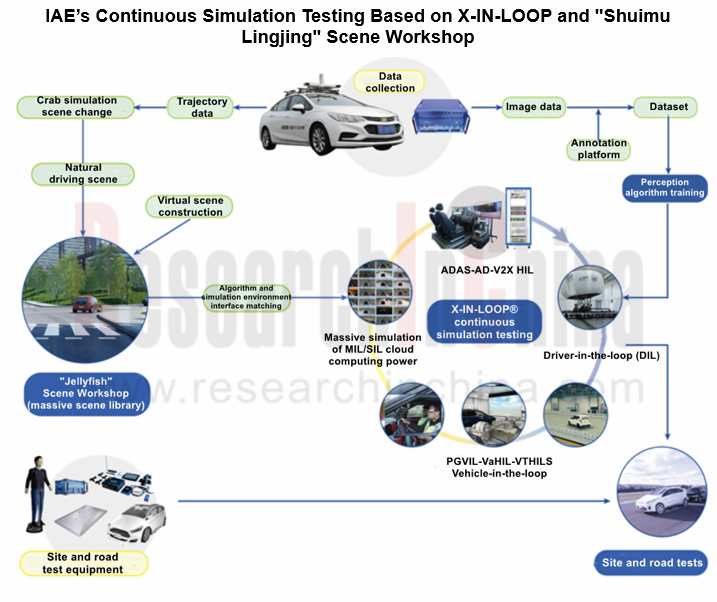
In addition, from simulation objects, it can be seen that the trend for autonomous vehicle and V2X integrated simulation is accelerating. In current simulation software, road signs, marking lines, and road facilities act as static environment elements. As vehicle-infrastructure cooperation and Internet of Vehicles technologies advance, infrastructures such as road perception and communication will participate in the interaction of driving behaviors between autonomous vehicles, and the simulation of vehicle behaviors will pose new technical requirements as urban intelligent infrastructures work.
Autonomous Driving Domain Controller and Central Computing Unit (CCU) Industry Report, 2025
Research on Autonomous Driving Domain Controllers: Monthly Penetration Rate Exceeded 30% for the First Time, and 700T+ Ultrahigh-compute Domain Controller Products Are Rapidly Installed in Vehicles
L...
China Automotive Lighting and Ambient Lighting System Research Report, 2025
Automotive Lighting System Research: In 2025H1, Autonomous Driving System (ADS) Marker Lamps Saw an 11-Fold Year-on-Year Growth and the Installation Rate of Automotive LED Lighting Approached 90...
Ecological Domain and Automotive Hardware Expansion Research Report, 2025
ResearchInChina has released the Ecological Domain and Automotive Hardware Expansion Research Report, 2025, which delves into the application of various automotive extended hardware, supplier ecologic...
Automotive Seating Innovation Technology Trend Research Report, 2025
Automotive Seating Research: With Popularization of Comfort Functions, How to Properly "Stack Functions" for Seating?
This report studies the status quo of seating technologies and functions in aspe...
Research Report on Chinese Suppliers’ Overseas Layout of Intelligent Driving, 2025
Research on Overseas Layout of Intelligent Driving: There Are Multiple Challenges in Overseas Layout, and Light-Asset Cooperation with Foreign Suppliers Emerges as the Optimal Solution at Present
20...
High-Voltage Power Supply in New Energy Vehicle (BMS, BDU, Relay, Integrated Battery Box) Research Report, 2025
The high-voltage power supply system is a core component of new energy vehicles. The battery pack serves as the central energy source, with the capacity of power battery affecting the vehicle's range,...
Automotive Radio Frequency System-on-Chip (RF SoC) and Module Research Report, 2025
Automotive RF SoC Research: The Pace of Introducing "Nerve Endings" such as UWB, NTN Satellite Communication, NearLink, and WIFI into Intelligent Vehicles Quickens
RF SoC (Radio Frequency Syst...
Automotive Power Management ICs and Signal Chain Chips Industry Research Report, 2025
Analog chips are used to process continuous analog signals from the natural world, such as light, sound, electricity/magnetism, position/speed/acceleration, and temperature. They are mainly composed o...
Global and China Electronic Rearview Mirror Industry Report, 2025
Based on the installation location, electronic rearview mirrors can be divided into electronic interior rearview mirrors (i.e., streaming media rearview mirrors) and electronic exterior rearview mirro...
Intelligent Cockpit Tier 1 Supplier Research Report, 2025 (Chinese Companies)
Intelligent Cockpit Tier1 Suppliers Research: Emerging AI Cockpit Products Fuel Layout of Full-Scenario Cockpit Ecosystem
This report mainly analyzes the current layout, innovative products, and deve...
Next-generation Central and Zonal Communication Network Topology and Chip Industry Research Report, 2025
The automotive E/E architecture is evolving towards a "central computing + zonal control" architecture, where the central computing platform is responsible for high-computing-power tasks, and zonal co...
Vehicle-road-cloud Integration and C-V2X Industry Research Report, 2025
Vehicle-side C-V2X Application Scenarios: Transition from R16 to R17, Providing a Communication Base for High-level Autonomous Driving, with the C-V2X On-board Explosion Period Approaching
In 2024, t...
Intelligent Cockpit Patent Analysis Report, 2025
Patent Trend: Three Major Directions of Intelligent Cockpits in 2025
This report explores the development trends of cutting-edge intelligent cockpits from the perspective of patents. The research sco...
Smart Car Information Security (Cybersecurity and Data Security) Research Report, 2025
Research on Automotive Information Security: AI Fusion Intelligent Protection and Ecological Collaboration Ensure Cybersecurity and Data Security
At present, what are the security risks faced by inte...
New Energy Vehicle 800-1000V High-Voltage Architecture and Supply Chain Research Report, 2025
Research on 800-1000V Architecture: to be installed in over 7 million vehicles in 2030, marking the arrival of the era of full-domain high voltage and megawatt supercharging.
In 2025, the 800-1000V h...
Foreign Tier 1 ADAS Suppliers Industry Research Report 2025
Research on Overseas Tier 1 ADAS Suppliers: Three Paths for Foreign Enterprises to Transfer to NOA
Foreign Tier 1 ADAS suppliers are obviously lagging behind in the field of NOA.
In 2024, Aptiv (2.6...
VLA Large Model Applications in Automotive and Robotics Research Report, 2025
ResearchInChina releases "VLA Large Model Applications in Automotive and Robotics Research Report, 2025": The report summarizes and analyzes the technical origin, development stages, application cases...
OEMs’ Next-generation In-vehicle Infotainment (IVI) System Trends Report, 2025
ResearchInChina releases the "OEMs’ Next-generation In-vehicle Infotainment (IVI) System Trends Report, 2025", which sorts out iterative development context of mainstream automakers in terms of infota...